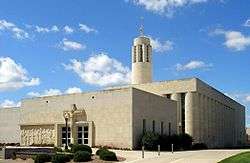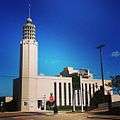Edward J. Schulte
Edward J. Schulte (April 27, 1890, in Cincinnati, OH – June 7, 1975, in Cincinnati, OH)[1] was an architect who designed a number of mid-twentieth-century churches notable for their blending of a modern idiom with traditional function. Inspired by an encounter with Ralph Adams Cram, he devoted himself to building church buildings, designing over 88.[2] He served as president of the Cincinnati chapter of the American Institute of Architects.[3]
Schulte had a sole practice after 1912, then practiced with Robert E. Crowe from 1921–1923, and practiced alone after that to 1967.[4]
Early life and education
Edward Schulte displayed a talent for drawing early on and was encouraged to pursue it by the nuns in the parochial school he attended as a child. His father, a building contractor, wanted him to take up architecture instead, suggesting him to the firm of Werner and Adkins, who had designed a Carnegie library for Norwood. (Schulte’s father was one of three trustees to build it.) Schulte began working for Werner and Adkins during the day while attending classes at the Art Academy at night, eventually becoming a valued member of the firm with a special skill for watercolor renderings of proposed projects for client presentations. Before long, however, Werner and Adkins began to suffer from financial problems, temporarily loaning Schulte out to another firm before bringing him back upon securing a new partner – H.E. Kennedy – and several new commissions, among them an office building for New Orleans.
Early career
Kennedy was awarded the commission to design the Harris Theater in downtown Pittsburgh and had Schulte design it – a task that required him to spend long nights in the library researching precedents for the relatively new building typology. Among the draftsmen for the project was Robert E. Crowe, who would later become Schulte's partner and most important collaborator. Upon the success of the Harris Theatre project, Kennedy moved his office to Pittsburgh, bringing Schulte along with him. It was during this time that Schulte attended a candlelit lecture by Ralph Adams Cram at the Hall of Architecture in the Carnegie Museum, inspiring him to focus on churches over the remainder of his career. Schulte was the only architect of the Twentieth Century to design four cathedrals. He also renovated St. Peter in Chains Cathedral in Cincinnati.[5]
List of buildings designed or overseen
This list of Schulte's work was compiled by Donald A. Tenoever:[6]
|
ROBERT CROWE & EDWARD SCHULTE (1921–1934)
EDWARD SCHULTE (1934–1967)
1935–1936
1936–1937
1938–1939
1939–1940
1941–1942
1942–1943
1944–1945
1945–1946
|
1947–1948
1949–1950
1951–1952
1953–1955
1956–1958
1959–1961
1962–1964
1965–1967
|
Gallery
- Christ the King Chapel
Davenport, Iowa  Sacred Heart Cathedral
Sacred Heart Cathedral
Salina, Kansas St. Mary's Cathedral
St. Mary's Cathedral
Covington, Kentucky- Villa Madonna Academy
Covington, Kentucky %2C_exterior.jpg) Cathedral of Christ the King
Cathedral of Christ the King
Lexington, Kentucky St. Paul Church
St. Paul Church
Vicksburg, Mississippi.jpg) Immaculate Conception Church
Immaculate Conception Church
Albuquerque, New Mexico_-_interior%2C_sanctuary_%26_mosaic.jpg) St. Peter in Chains Cathedral
St. Peter in Chains Cathedral
Cincinnati, Ohio- St. Anthony of Padua Church
Dayton, Ohio - St. Michael Church
Houston, Texas .jpg) Christ the King Church
Christ the King Church
University Park, Texas- Cathedral of Saint Joseph the Workman
La Crosse, Wisconsin
Publications
- The Cathedral (1956)
- The Lord Was My Client (1972)
References
- Schulte, Edward. "Find-a-grave".
- Heavenly City, p. 142, Denis R. McNamara, James Morris (Liturgy Training, 2005)
- The Spirit of Mediator Dei, Denis McNamara, Sacred Architecture, Vol. 4 (2000)
- "Biographical Dictionary of Cincinnati Architects". Archived from the original on 2011-10-05. Retrieved 2009-02-23.
- http://www.thecatholictelegraph.com/symposium-honors-legacy-of-local-church-architect/490
- Tenoever, Donald A. "Edward J. Schulte and American Church Architecture of the Twentieth Century" (PDF). Donald A. Tenoever, Master's Thesis, University of Cincinnati. Retrieved 2015-02-07.
- "Bishop Marty Memorial Chapel". Council of Independent Colleges. Archived from the original on 2012-02-13. Retrieved 2015-02-07.
Other references
- Edward J. Schulte and American Church Architecture of the Twentieth Century, Donald A. Tenoever, master's thesis, University of Cincinnati, 1974